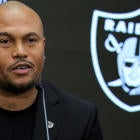Le'Veon Bell was born five to seven years too late to take advantage of market conditions favorable to running backs. If he'd had a rookie contract that expired in 2012, Bell would have been better positioned to leverage his outstanding production into a landmark contract. Instead, the 2013 second-round pick is in a much different financial climate for running backs.
Bell rejected a contract offer in 2017 that the NFL Players Association reportedly found appropriate as the mid-July deadline for franchise players to sign multi-year deals approached. Instead, Bell waited until a few days before the regular-season opener to sign his franchise tender.
Multiple reports initially put the offer in the $60 million neighborhood for five years. The reports differed on other details of the offer. There was $39 million to $42 million over the first three years. Bell recently confirmed to ESPN's Jeremy Fowler that the deal averaged $13.3 million per year. It's unclear whether that was just for the first three years of the deal or over the entire five years. Bell alluded to needing $15 million per year in a rap song last year.
So, will Bell be able to reset and potentially save the running-back market? Is he overplaying his hand? Let's take a look at what history and the numbers say.
Bell's performance
Bell solidified his place as the game's best dual-threat running back in 2017. He was third in the NFL with 1,291 rushing yards despite a sluggish start to the season due to him waiting so long to get under contract, as well as sitting out the season finale for precautionary measures with the playoffs looming. His 1,946 yards from scrimmage (combined rushing and receiving yards) were second most in the league. He also led running backs with 85 receptions.
Bell built upon a 2016 in which he validated his 2014 breakout campaign. He joined Marshall Faulk and Steven Jackson as the only running backs to record at least 1,300 rushing yards (1,361) and 800 receiving yards (854) in the same season with his 2016 performance.
Bell also became the first player in NFL history to average at least 100 rushing yards per game (105.7) and 50 receiving yards per game (51.3) for a season. His 157 yards from scrimmage per game were the third best mark in an NFL season behind only Priest Holmes (163.4 in 2002) and O.J. Simpson (160.2 in 1975).
Bell is amassing yardage at a historic and unprecedented rate. His 129 yards from scrimmage per game are the most in NFL history (minimum of 50 career games). Hall of Famer Jim Brown is second with 125.5 per game. Nobody has ever been better at picking up yards during the first five seasons of their NFL career. Edgerrin James and Eric Dickerson are right behind Bell with 126 and 125.7 yards per game.
Recent developments
The Steelers designated Bell as an exclusive franchise player for a second-straight season at $14.544 million, which is a CBA-mandated 20-percent increase over his $12.12 million 2017 salary, after an agreement on a new contract couldn't be reached by the Feb. 20 artificial deadline set by the parties. The Steelers reportedly had added money to the offer made in 2017 when negotiations picked up again this offseason. Feb. 20 was the first day teams could use the franchise or transition designation on players. The exclusive franchise tag prevents Bell from soliciting offer sheets from other teams.
Not surprisingly, Bell has increased his contract demands after continuing to demonstrate last season that he is the NFL's most complete running back. He wants the same $17 million per year that wide receiver Antonio Brown got from the Steelers in a contract extension last year, according to the NFL Network.
Bell can make a legitimate case that he has transcended his position and should be compared to game's highest-paid offensive playmakers instead of just running backs. This is because Bell is arguably the NFL's most dangerous offensive weapon, thanks to his running ability and receiving skills.
General manager Kevin Colbert announced a couple of weeks ago at the NFL Annual Owners Meeting that talks were on hold to focus on more pressing matters: free agency and the NFL draft. He indicated that talks would eventually resume before the July 16 long-term deal deadline for franchise players. Bell plans on taking the same approach as last year absent a long-term deal. The willingness to pay Bell $26.664 million over two years with franchise tags suggests that the Steelers should be comfortable paying him in neighborhood of $13.5 million per year on a long-term deal.
The pinnacle of RB salaries
Adrian Peterson and Chris Johnson took running-back salaries to a new level in 2011 after several years of stagnation by signing deals that put them among the NFL's five highest-paid non-quarterbacks. Johnson signed a four-year extension with the Titans averaging $13,493,750 per year and containing $30 million in guarantees after a lengthy preseason holdout. Peterson received a six-year, $85.28 million extension, which included $36 million in guarantees and an additional $4 million in base salary escalators, from the Vikings.
Running back compensation reached a peak in 2012, when the number of players with veteran contracts averaging at least $7 million per year jumped from five in 2011 to 11 in 2012. Currently, there are only three ball carriers at or above the $7 million threshold.
The chart below highlights the decline at the top of the veteran running-back market since its high-water mark by looking at the average of the top five running back long-term contracts in a couple of basic metrics.
Average contract guarantees | Average yearly salary | Average contract length | $10M-per-year RBs | $7M-per-year RBs | |
2012 | $25,803,000 | $10,834,100 | 5 years | 2 | 11 |
2013 | $25,203,000 | $10,763,333 | 4.8 years | 2 | 9 |
2014 | $19,153,000 | $10,103,636 | 4.4 years | 1 | 7 |
2015 | $16,450,000 | $9,861,765 | 3.4 years | 2 | 8 |
2016 | $17,500,000 | $8,620,000 | 4 years | 1 | 5 |
2017 | $17,519,400 | $7,293,750 | 4.8 years | 0 | 3 |
2018 | $17,319,400 | $7,276,190 | 4.2 years | 0 | 3 |
Note: The chart includes veteran contracts only. FB Kyle Juszczyk is not included in 2018.
The $10 million-per-year running back is now nonexistent, although Bell could have easily become the only one by accepting the offer Pittsburgh made last year, which was considerably more than the current $8.25 million-per-year benchmark held by the Falcons' Devonta Freeman. Compensation at other positions isn't experiencing the same phenomenon that's been occurring at running back.
Wide-receiver salaries have exploded. There were just three wide receivers with long-term contracts averaging at least $10 million per year in 2012. Seventeen wide receivers currently have multi-year deals at or above the $10 million-per-year mark. Since the beginning of 2017, eight wideouts have gotten long-term deals reaching the $10 million threshold. DeAndre Hopkins helped advance the ball for wide receivers by setting new standards for pass catchers last preseason with $49 million in overall guarantees and $36.5 million fully guaranteed at signing, which have since been eclipsed by Mike Evans. The Buccaneers last month gave the 2014 first-round pick a five-year extension averaging $16.5 million per year with $55.008 million in guarantees where $38.258 million is fully guaranteed.
Second contracts and the franchise tag
There's a school of thought in the NFL that a team should avoid giving a running back an extremely lucrative second contract unless he's a special talent. The preference under this philosophy is to go year-to-year with a fifth-year option, when applicable, and with franchise or transition tags until it's no longer economically feasible. Simultaneously, an attempt to find a suitable replacement in the draft should be made either toward the end of the rookie contract or while the veteran is playing under a designation. This protects against overpaying while a running back is in his late twenties, when he is likely to be in decline because of high mileage.
Productive ball carriers can be found all over the NFL draft. For example, 2017 Offensive Rookie of the Year Alvin Kamara was a third-round pick of the Saints. Kareem Hunt, the Chiefs' 2017 third-round pick, led the NFL in rushing last season. Jordan Howard, a fifth-round pick in 2016, has gotten more than 1,000 rushing yards in both of his NFL seasons with the Bears.
The Steelers are comfortable resetting the running-back market by a wide margin but seem unwilling to put Bell in same relative position as Peterson and Johnson in the non-quarterback-salary hierarchy. Chiefs outside linebacker Justin Houston is currently the league's fifth-highest paid non-quarterback at $16,833,333 per year.
The Steelers appear to be contemplating hedging their bets on Bell. The interest in LSU running back Derrius Guice, who could still be available when Pittsburgh selects 28th in the draft later this month, seems sincere and isn't just a negotiating ploy.
Bell won't get franchised for a third time. The procedures outlined in the NFL's Collective Bargaining Agreement dictate that Bell's tag will be the quarterback number in 2019, which could be approaching $25 million. The current quarterback tag is $23.189 million.
Another option the Steelers would have if a long-term deal isn't in place by next March is placing the seldom-used transition tag on Bell. The Steelers have made the most extensive use of the transition-player designation in recent years. Offensive tackle Max Starks and outside linebacker Jason Worilds played under the designation in 2008 and 2014.
Bell's transition number would be $17,542,800, which is 120 percent more than his current franchise tag. A transition tag would only provide the Steelers a right to match an offer sheet from another team. There wouldn't be any draft-choice compensation, like with the non-exclusive franchise tag, if the Steelers didn't exercise their matching rights. Although the Steelers would be vulnerable to an offer sheet with a structure that isn't consistent with their other contracts, it would be a way for both sides to find out Bell's true market value.
Pittsburgh contracts typically have a vanilla structure. With the exception of Ben Roethlisberger, the only guaranteed money in Pittsburgh deals is a signing bonus. Roethlisberger's guarantees are for injury only. The bigger deals contain a third- or fifth-day-of-the-league-year roster bonus in the second year. The roster bonuses are supposed to be substitutes for additional contract guarantees. The overall guarantees in Pittsburgh contracts are usually less than comparable to other teams' deals.
Bell would make a little more than $44 million over three years by Pittsburgh continuing to go year-to-year with a transition tag in 2019. It's a couple of million more than what Bell reportedly would have received in the first three years of the offer he turned down in 2017.
If not Bell, then who?
The dynamic young running backs still on rookie contracts should be rooting for Bell to sign a long-term contract in Pittsburgh as soon as possible. A new Bell deal in the market place will make their respective negotiations much easier since he would be raising the salary bar for ball carriers. Even without Bell getting a new contract, their respective agents should take the position that the deal Bell rejected is more representative of their clients' value than Freeman's extension.
Todd Gurley and David Johnson, who are both 2014 draft picks, are in the best position to change the running-back market if Bell doesn't. Both are eligible to sign extensions.
There's more of a sense of urgency with Johnson, who was taken in third round by the Cardinals, since he is entering his contract year. He is making $1.907 million in the final year of his rookie contract.
Johnson arguably became the NFL's best dual-threat running back during a breakout 2016 campaign in which he led the NFL with 2,118 yards from scrimmage while earning first team All-Pro honors. 2017 was a lost season for Johnson, who didn't play again after breaking his left wrist in the season opener.
The Cardinals' rushing attack really suffered without him. Arizona had the NFL's third-worst running offense, generating only 86.6 rushing yards per game and ranking next to last with 3.4 yards per carry.
Johnson returning to his 2016 form will make him a prime candidate for a franchise tag if he plays out his rookie contract. The declining running-back market of the last few years is going to have an impact on the 2019 running-back franchise tag. Assuming the 2019 salary cap is set in the $190 million neighborhood, Johnson's franchise tag projects to $11.3 million. This is approximately $800,000 less than Bell's first franchise tag in 2017.
Gurley, the 2015 NFL Offensive Rookie of the Year, bounced back from a disappointing 2016. He was named NFL Offensive Player of the Year in 2017 after leading the NFL with 2,093 yards from scrimmage and 19 touchdowns despite sitting out the season finale because the Rams couldn't earn a playoff bye.
The Rams will surely exercise their $9.63 million fifth-year option with Gurley. Fortunately for Gurley, the Rams have a track record of signing productive first-round picks to extensions either before the start of or during the early part of their fourth season, although that wasn't the case with reigning NFL Defensive Player of the Year Aaron Donald in 2017. Signing Donald to an extension this offseason is a major priority.
Recommendation
The Steelers using their first- or second-round pick on a running back will be a sign that Bell's days in Pittsburgh are probably numbered. As great as Bell has been, the most prudent course of action may be for the Steelers to utilize Bell this season like the Cowboys did DeMarco Murray in 2014 while finding his successor in this year's draft.
Murray was named Offensive Player of Year after breaking Emmitt Smith's single-season franchise rushing record by gaining a league leading 1,845 yards on the ground in 392 carries, the eighth-most ever in an NFL regular season. He had another 44 carries in the playoffs to bring his total to 436 rushing attempts.
Murray wasn't offered a lucrative long-term second contract because of a belief that he benefitted from running behind a great offensive line, and history suggested he would be a case of diminishing returns after the heavy workload in 2014. Murray didn't thrive with the Eagles after signing a five-year, $40 million contract, which included $21 million in guarantees and was worth a maximum of $42 million through salary escalators. He found his groove in 2016 after cutting $5.45 million out of the base value of the remaining four years of his contract to help facilitate a trade from the Eagles to the Titans while adding $1.85 million of annual incentives. Murray led the AFC with 1,287 rushing yards. He is currently unsigned after a disappointing 2017 season led to his release this offseason.
An unprecedented workload for a running back shouldn't be out of the question for Bell this season. James Wilder holds the single-season record for touches (combined rushing attempts and receptions) with 492 for the Buccaneers in 1984. Three running backs -- Jamal Anderson, Terrell Davis and Emmitt Smith -- have had seasons with over 500 touches, if playoff games are included. Davis' 531 touches in 1997 when the Broncos won Super Bowl XXXII, which included 120 in four playoff games, are the most ever in an NFL season. A healthy and productive 2018 with heavy usage ought to put the transition tag in play, although Bell's eventual successor would already be waiting in the wings.
It isn't going to happen, but the Steelers should explore trying make a trade with the Browns centered around obtaining the fourth-overall pick to get in a position to draft Penn State's Saquon Barkley where Cleveland gets Bell. Obviously, other draft picks would need to be included. At a minimum, Cleveland would also get the 28th overall pick in this year's draft from Pittsburgh.
Logistically, it would likely have to be a sign-and-trade where the Cleveland and Bell camps reached an agreement on a long-term deal for the transaction to work. The Browns have an NFL-best $68.9 million in 2018 cap space, so financial resources wouldn't be an impediment. Bell's cooperation would be needed since he can't be traded while his franchise tender remains unsigned. He would be reunited with Todd Haley, who became Cleveland's offensive coordinator when the Steelers parted ways with him after an upset loss to the Jaguars in the divisional playoffs. Haley spent the last six seasons as Pittsburgh's play caller.
Barkley is considered by some to be the best running-back prospect in the last 25 years. Pittsburgh would have Barkley under contract over the next four years at roughly half of cost of Bell for the same period with an option for a fifth year in 2022. The four-year rookie contract Barkley would sign as the fourth pick should be in the $29 million neighborhood.





















